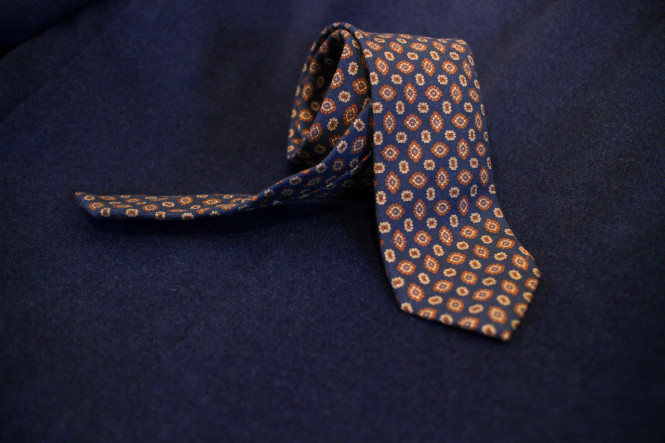Long-time readers of this site have grown accustomed to the fact that my wardrobe isn’t particularly fancy or extensive; I’m a pretty normal guy with a pretty normal amount of expendable income, and for that reason I tend to stick to the basics when purchasing clothing. Navy blazers, grey slacks, brown shoes and light blue shirts occupy the majority of my formal wardrobe. That’s not to say that I only like simple things, but I’m adamant about making my dollar go as far as possible for every purchase. Simple is always better – that’s the mantra I’ve been subscribed to.
But I’ve come to learn that it’s not always true.
When I began building my necktie collection I approached it with the same fervent adhesion to minimalism; the ties I bought were solid and simple, chosen for their ultimate versatility. I stand by those purchases, but I have found that dressing well can be a bit more sophisticated than just sticking to the simplest clothing. Sometimes complicated is better.
Although it is true that a simple garment in a neutral color will ultimately be the most versatile, it turns out that an outfit comprised solely of these items can be difficult to wear well. Something about wearing only simple clothing – nothing but solid, neutral garments – is a bit too barren and minimalistic, despite it seeming like the best choice. Looking back, I think this is the same concept that Derek was driving towards in this article on Put This On. Through this realization I have come to enjoy the complicated tie – it’s the opposite of what I normally wear, and for that reason it fits in perfectly.
The complicated tie as I define it can take many forms – simple neats, repp stripes, ancient madders, and so on. In the right context, any of these can be extremely useful in breaking up neutral items to avoid seeming overly staid. The patterns and colors don’t seem to stick out as much as they should; rather than becoming a focal point, a well-chosen complicated tie can become the glue that holds an outfit together. It’s difficult to explain, but once you try it you’ll understand what I”m getting at.
There are lots of complicated ties out there, many of which look terrible. It’s hard for me to explain why some complicated ties are quite tasteful and others are hard to look at, but ultimately I think that the same rules I apply to my wardrobe still apply to busy ties. Even though the pattern may add complexity, if the colors are muted and the design is classic then the overall effect should be good.
So the next time you’re trying to dress in a subtle and understated manner, don’t go too far. Even the most pared down looks can benefit from a bit of visual interest, and a tie can be a great place to start. After all, dressing simply isn’t always simple – sometimes it’s a little bit complicated.
Pictured: a classic complicated tie from Eton at Khaki’s of Carmel
